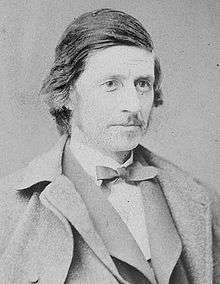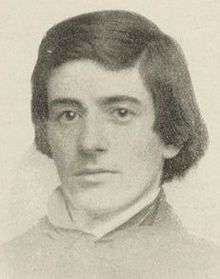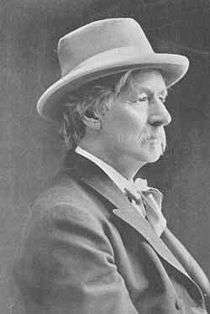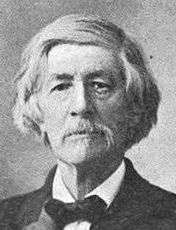Franklin Benjamin Sanborn
| Franklin Benjamin Sanborn | |
|---|---|
 | |
| Born |
December 15, 1831 Hampton Falls, New Hampshire |
| Died |
February 24, 1917 (aged 85) Plainfield, New Jersey |
| Cause of death | died subsequent to injuries suffered when struck by a baggage car at the train station, on a visit with his son Francis. |
| Resting place | Sleepy Hollow Cemetery, Concord, Massachusetts |
| Occupation | journalist, author, historian, abolitionist, social reformer |
| Religion | Unitarian |
| Children | Thomas Parker Sanborn, Victor Channing Sanborn, Francis Bachiler Sanborn |
| Signature | |
|
| |
Franklin Benjamin Sanborn (December 15, 1831 – February 24, 1917) was an American journalist, author, and reformer. Sanborn was a social scientist, and a memorialist of American transcendentalism who wrote early biographies of many of the movement's key figures. He founded the American Social Science Association, in 1865, "to treat wisely the great social problems of the day." He was a member of the Secret Six, or "Committee of Six," which funded the militant abolitionist John Brown.
Biography
Early years and education
Franklin Sanborn was born at Hampton Falls, New Hampshire, the son of Aaron and Lydia (Leavitt) Sanborn.[1] He already believed himself capable of making a stir in the world by the age of two, having held up a stick in a thunderstorm and experienced being struck by lightning. At age nine, following careful reading of the pro-emancipation journals The National Era and Horace Greeley's New-York Tribune, Frank announced to his family that slavery was wrong and the United States Constitution should be revised or revoked.[2]
In 1850, at the suggestion of his future wife Ariana Walker, Sanborn arranged to study with the Exeter teacher and private tutor John Gibson Hoyt. He would focus on Greek for a year, then enter Phillips Exeter Academy. This was followed by enrollment at Harvard, from which he graduated in 1855.
Professional life

Sanborn was active in politics as a member of the Free Soil Party in New Hampshire and Massachusetts.[3] In 1856, he became secretary of the Massachusetts Kansas Commission[4] and came into close touch with John Brown. Sanborn was one of six influential men who supplied Brown with support for the raid on Harper's Ferry on October 16–18, 1859. This group was later termed the Secret Six. Although Sanborn disavowed advance-knowledge of the attack, he would defend Brown to the end of his life, assist in the support of his widow and children, and make periodic pilgrimages to Brown's grave.[5]
On the night of April third, five federal marshalls arrived at Frank Sanborn's home in Concord, handcuffed him and attempted to wrestle him into a coach and take him to Washington to answer questions before the Senate in regard to his involvement with John Brown. Approximately 150 towns-people rushed to Sanborn's defense. Judge Ebenezer R. Hoar issued a writ of replevin, formally demanding the surrender of the prisoner. In a letter to a friend, Louisa May Alcott wrote, "Sanborn was nearly kidnapped. Great ferment in town. Annie Whiting immortalized herself by getting into the kidnapper's carriage so that they could not put the long legged martyr in."[6]
From 1863 to 1867 Sanborn was an editor of the Boston Commonwealth, from 1867 to 1897 of the Journal of Social Science, and from 1868 to 1914 a correspondent of the Springfield Republican. He was one of the founders of, and was closely identified with, the American Social Science Association (secretary 1865–1897), the National Prison Association, the National Conference of Charities, the Clarke School for the Deaf, the Massachusetts Infant Asylum, and the Concord School of Philosophy. He lectured at Cornell, Smith, and Wellesley.
In October 1863, he became secretary of the Massachusetts State Board of Charities, the first established in America.[3] He was secretary from 1863 to 1868, a member from 1870 to 1876, and chairman from 1874 to 1876. In 1875 he made a searching investigation into the abuses of the Tewksbury almshouse, and in consequence that institution was reformed. In 1879 he helped to reorganize the system of Massachusetts charities, with special reference to the care of children and insane persons, in July 1879 becoming State Inspector of Charities under the new board, serving until 1888.[4]
Personal life

Sanborn lived at Concord, Massachusetts. He was twice married, first to Ariana Walker in 1854 for eight days until she died. Following his first wife's death, Sanborn courted nineteen-year-old Edith Emerson, the daughter of Ralph Waldo Emerson of Concord.[7] Sanborn ultimately proposed to Miss Emerson in 1861, and was rejected. He apparently took offense, and launched into a series of letters to Miss Emerson's mother. Those letters apparently inflamed the Emerson family, with the result that Ralph Waldo drafted a chilly letter to Sanborn, informing Sanborn of Emerson's wife's displeasure at having been accused. The matter did not end happily, with Mrs. Emerson writing her own letter of reproach to Sanborn.[8]
Ultimately, Sanborn begrudgingly apologized and moved on. He married as his second wife his cousin Louisa Augusta Leavitt in 1862—said to look enough like Sanborn to be his sister—the daughter of Sanborn's uncle Joseph Melcher Leavitt, a Boston merchant (Sanborn's other uncle was Benson Leavitt, once a partner of his wife's father and later acting mayor of Boston). Louisa Leavitt had worked as a schoolteacher at the Concord school Sanborn founded. The couple were married at the Church of the Disciples in Boston by abolitionist minister James Freeman Clarke.[9] They had three sons, the poet Thomas Parker Sanborn, genealogist Victor Channing Sanborn, and Francis Bachiler Sanborn.[10]

In 1880, Frank Sanborn built a large house on the banks of the Sudbury River in Concord, placing a plaque with the name of his first wife, Ariana, in a gable end. It was in this home that the Sanborns' eldest son, Tom, committed suicide in 1889, at the age of twenty-four, after which the Sanborns stayed for several months in the Emerson home. In 1891 Frank Sanborn moved his ailing and elderly friend, transcendental poet and walking-companion of Thoreau, Ellery Channing, into his home, where Channing subsequently died in 1901.[11] Although the Sanborns' second son, Victor Channing Sanborn, was engaged in real estate for a living, he wrote frequently about his father and authored a book researching their ancestor Thomas Leavitt's origins.[12]
Death and significance

Frank Sanborn died February 24, 1917, after being struck by a railroad baggage car during a visit to his son Francis in New Jersey. He was buried at Sleepy Hollow Cemetery in Concord near the graves of his friends and mentors Ralph Waldo Emerson, Bronson Alcott, Ellery Channing, and Henry Thoreau. Concord's flags were flown at half-mast for three days. At the end of the month, February, 1917, just prior to America's entering World War I, the Massachusetts House of Representatives recognized Sanborn’s dedication to the unfortunate, the diseased, and the despised, citing Sanborn's role as a confidential adviser to John Brown, "for whose sake he was arrested, mistreated, and nearly deported."[13]
People loved and hated him. Walt Whitman described Sanborn as "a fighter, up in arms, a devotee, a revolutionary crusader, hot in the collar, quick on the trigger, noble, optimistic." Henry David Thoreau feared the passionate Concord schoolteacher was "only too steadfast and earnest", a type, as Thoreau put it, "that calmly, so calmly, ignites and then throws bomb after bomb." Sanborn lived a long life. He was revered in the end as a relic from a golden age gone by—a tall and venerable figure moving picturesquely through Boston and Concord.[14]
Works

- Thoreau (1872)
- Life and Letters of John Brown (1885)
- Dr. S. G. Howe (1891)
- A. Bronson Alcott: His Life and Philosophy (with William Torrey Harris) (1893)
- Emerson (1895)
- Dr. Earle (1898)
- Personality of Thoreau (1902)
- Personality of Emerson (1903)
- A History of New Hampshire (1904)
- Hawthorne and His Friends (1908)
- Bronson Alcott at Fruitlands (1908)
- Recollections of Seventy Years (1909)
- Thoreau and his Earliest Writings (1914)
- Sixty years in Concord (1916)
He contributed largely to the Proceedings of the Massachusetts Historical Society (1903–15). He also edited two volumes of Theodore Parker's Writings (1914), introduced Newton's Lincoln and Herndon (1913), and wrote brief biographies of Samuel Langdon (president of Harvard College), of Ellery Channing and of Mrs. Abbott-Wood of Lowell. He edited for the Boston Bibliophile Society five volumes of Thoreau's manuscripts, a volume of the Shelley-Payne correspondence, and one of the Fragments and Letters of T. L. Peacock.[3] He edited writings of Paul Jones.
See also
Notes
- ↑ New Hampshire Biography and Autobiography, Franklin Benjamin Sanborn, Privately printed, Concord, New Hampshire, 1905
- ↑ Significance of Being Frank: the Life and Times of Franklin Benjamin Sanbornby Tom Foran Clark.
- 1 2 3
 Rines, George Edwin, ed. (1920). "Sanborn, Franklin Benjamin". Encyclopedia Americana.
Rines, George Edwin, ed. (1920). "Sanborn, Franklin Benjamin". Encyclopedia Americana. - 1 2
 Wilson, James Grant; Fiske, John, eds. (1900). "Sanborn, Charles Henry". Appletons' Cyclopædia of American Biography. New York: D. Appleton.
Wilson, James Grant; Fiske, John, eds. (1900). "Sanborn, Charles Henry". Appletons' Cyclopædia of American Biography. New York: D. Appleton. - ↑ Rehehan, Edward J. Jr., The Secret Six: The True Tale of the Men Who Conspired with John Brown, New York, Crown Publishers, Inc., 1995
- ↑ Clark, 2196-2232.
- ↑ Sanborn's aunt Miss Alice Leavitt (his mother's sister), was personal nurse to Ralph Waldo Emerson's widow Lydian.
- ↑ The Letters of Ralph Waldo Emerson, Ralph Waldo Emerson, Ralph Leslie Rusk, Eleanor Marguerite Tilton, Columbia University Press, 1931 ISBN 0-231-08102-2 ISBN 978-0-231-08102-3
- ↑ The Concord Magazine, November 1998
- ↑ The New England Historical and Genealogical Register, Vol. LXXI, 1917, New England Historic Genealogical Society, Published by the Society, Boston, 1917
- ↑ The Significance of Being Frank: the Life and Times of Franklin Benjamin Sanborn by Tom Foran Clark
- ↑ Franklin Benjamin Sanborn, by Victor Channing Sanborn of Kenilworth, Illinois, The New England Historical and Genealogical Register, October 1917, The New England Historic Genealogical Society, Vol. LXXI, Published by the Society, Boston, Mass., 1917
- ↑ The Significance of Being Frank: the Life and Times of Franklin Benjamin Sanborn by Tom Foran Clark(Kindle Locations 48-49).
- ↑ The Significance of Being Frank: the Life and Times of Franklin Benjamin Sanborn by Tom Foran Clark(Kindle Locations 54-62).
References
-
 This article incorporates text from a publication now in the public domain: Gilman, D. C.; Thurston, H. T.; Colby, F. M., eds. (1916). "Sanborn, Franklin Benjamin". New International Encyclopedia. 20 (1st ed.). New York: Dodd, Mead. p. 410.
This article incorporates text from a publication now in the public domain: Gilman, D. C.; Thurston, H. T.; Colby, F. M., eds. (1916). "Sanborn, Franklin Benjamin". New International Encyclopedia. 20 (1st ed.). New York: Dodd, Mead. p. 410.
Further reading
- A. Bronson Alcott: his life and philosophy, Volume 1 Franklin Benjamin Sanborn, William Torrey Harris, John Wilson and Son, Cambridge, Mass., 1893
- Sanborn, Victor Channing. “Franklin Benjamin Sanborn, A.B., 1831-1917.” Kansas Historical Collection, 1915-1918 13 (1918): 58-70. Followed by "Personal Reminiscences" by W. E. Connelley of the New Englander who was "one of the early friends of Kansas," as well as a friend, supporter, and later biographer of John Brown.
- Sanborn, Franklin Benjamin, Ungathered Poems and Transcendental Papers, Kenneth Walter Cameron, editor, Transcendental Books, Hartford, Connecticut, 1981.
External links
| Wikimedia Commons has media related to Franklin Benjamin Sanborn. |
| Wikisource has original works written by or about: Franklin Benjamin Sanborn |
- Works by F. B. Sanborn at Project Gutenberg
- Works by or about Franklin Benjamin Sanborn at Internet Archive
- The Significance of Being Frank: The Life and Times of Franklin Benjamin Sanborn, by Tom Foran Clark
- Franklin Benjamin Sanborn Papers, 1845–1936, Concord Free Public Library, Concord, Massachusetts
- Biography of F.B. Sanborn, Concord Free Public Library, Concord, Massachusetts, available on line at
- Franklin Benjamin Sanborn at Find A Grave